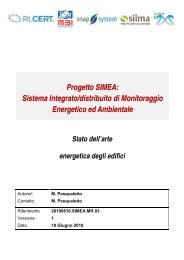Stato dell'arte energetica degli edifici - Automatica - Università degli ...
Stato dell'arte energetica degli edifici - Automatica - Università degli ...
Stato dell'arte energetica degli edifici - Automatica - Università degli ...
Create successful ePaper yourself
Turn your PDF publications into a flip-book with our unique Google optimized e-Paper software.
SIMEA <strong>Stato</strong> dell’arte <strong>energetica</strong> <strong>degli</strong> <strong>edifici</strong><br />
1.2.38. PowerDomus<br />
71<br />
Doc.No 20100610.SIMEA.MR.03<br />
Versione 1<br />
PowerDomus is a whole- building simulation tool for<br />
analysis of both thermal comfort and energy use. It has been<br />
developed to model coupled heat and moisture transfer in<br />
buildings when subjected to any kind of climate conditions, i.e.,<br />
considering both vapor diffusion and capillary migration. Its<br />
models predict temperature and moisture content profiles within<br />
multi-layer walls for any time step and temperature and relative<br />
humidity for each zone, by using the finite-volume approach and<br />
the mathematical method developed by Mendes et al. (2002).<br />
The use of this method avoids numerical oscillations, since it<br />
keeps the discrete equations strongly coupled between themselves, preventing the occurrence of physically<br />
unrealistic behaviour when time step is increased and producing a numerically stable method, which is very<br />
suitable 11 to be used in building yearly energy simulation programs. Integrated simulation of HVAC<br />
systems can be performed for both direct and indirect expansion systems.<br />
PowerDomus allows users to visualize the sun path and inter-buildings shading effects and provides<br />
reports with graphical results of zone temperature and relative humidity, PMV and PPD, thermal loads<br />
statistics, temperature and moisture content within user-selectable walls/roofs, surface vapor fluxes and<br />
daily-integrated moisture sorption/ desorption capacity.<br />
On-off and PID control strategies can be applied to individual heaters or DX-systems and 1-minute<br />
time intervals for schedules can be considered all over.<br />
For the floor, the Dirichlet conditions for temperature and moisture content at the lower soil surface or<br />
adiabatic and impermeable conditions for deeper surfaces can be considered. There is also the possibility to<br />
read temperature and moisture content data generated by the Solum 3-D Simulation model (Santos and<br />
Mendes, 2003), which provides spatial distribution of temperature and moisture content in soils for each<br />
user-defined time sample.<br />
PowerDomus has been conceived to be a very user- friendly software in order to stimulate a larger<br />
number of users to use building simulation software. It has been developed in the C++ language under C++<br />
Builder environment using a 3-D OpenGL graphical interface and it is available on the PC platform under<br />
Windows 2000 and XP operating systems.
















